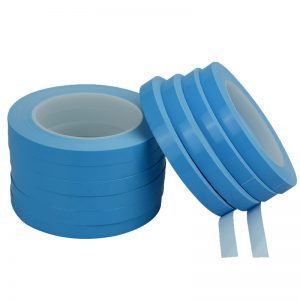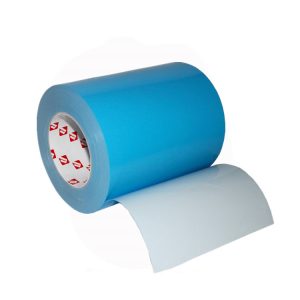





Thermally conductive double-sided tape we provide are transfer thermal conductive tapes and glass fiber thermal conductive tapes both with relese liner.
| Product Code | P8005 | P8010 | P8015 | P8020 | P8025 | P8030 | P8040 | P8050 | P8070 | |
| Name | Thermal Conductive Transfer Adhesive Tape | Thermal Conductive Glass Fiber Doulbe Coated Adhesive Tape | ||||||||
| Carrier Type | None | Fiberglass | Fiberglass | Fiberglass | Fiberglass | Fiberglass | Fiberglass | Fiberglass | Fiberglass | |
| TotalThickness (mm) | 0.05 | 0.1 | 0.15 | 0.2 | 0.25 | 0.3 | 0.4 | 0.5 | 0.7 | |
| Surface Adhesion (N/25mm) | 10 | 11 | 12 | 13 | 13 | 15 | 15 | 15 | 18 | |
| Initial Tack (N/25mm) | 8 | 12 | 14 | 14 | 16 | 16 | 16 | 16 | 16 | |
| Short-term temperature | 120 | 120 | 120 | 120 | 120 | 120 | 120 | 120 | 120 | |
| Long-term temperature | 80 | 80 | 80 | 80 | 80 | 80 | 80 | 80 | 80 | |
| Withstanding Voltage(Kv/mm) | 3 | 3 | 3.5 | 4.5 | 5 | 6 | 7 | 8 | 9 | |
| Thermal Conductivity(w/mk) | ||||||||||
Double-sided tape quality inspection
- Check for cracks on the double-sided tape
When the double-sided tape is slit, if the slitting knife is not adjusted properly or the blade is not sharp enough, cracks will appear on the surface or bottom paper of the double-sided tape, and the fibers pulled out of the crack will be stuck by the adhesive. The occurrence of cracks may be continuous or random, and may appear on one side of the roll of double-sided tape, or on both sides. Therefore, before machining on the double-sided tape, you must carefully check the bottom paper and surface. Whether there are small cracks on the paper.
Then, take a piece of sample paper that has passed the above inspection, peel it off the bottom paper and check again whether there are cracks on the bottom paper and the bottom paper, because the cracks are sometimes very small and can only be found after separating the bottom paper and the top paper.
- Check whether the double-sided tape has burrs
The double-sided tape rolls have smooth edges and no damage, which is the basis for ensuring the quality of the double-sided tapes. Therefore, before processing, you must carefully check whether the slitting edges of the rolls double-sided tape have burrs and whether they are damaged due to improper storage and transportation. , And roll down the roll of double-sided tape 4-5 times, carefully check the cutting edge.
Immediately after the inspection method for the appearance of double-sided tape we mentioned above, today we will add some knowledge about this aspect.
- Check if the edges of the double-sided tape are stuck, and if the bottom paper is missing silicon
The edge of the double-sided tape is stuck or the silicone oil is missing in some areas on the bottom paper, which will cause the surface paper to break during the waste discharge during the processing process, and the normal production cannot be performed. Therefore, before processing, take a length of about 1 meter of self-adhesive material and peel it off by hand to see if there are any parts on the edge or other parts that cannot be peeled smoothly and uniformly. Usually, the edge adhesion between the face paper and the bottom paper occurs on a slit roll of the entire roll of coated self-adhesive material, and generally only occurs at the outer layer of 7 meters to 10 meters, so when you encounter a slit roll There is adhesion on the edge of the double-sided tape. Don’t immediately assert that the entire roll of paper has this problem.
In addition, it should be noted that peeling off light-weight facial paper (such as 60g/m2 and 80g/m2 facial paper) is stronger than peeling heavy-weight facial paper. The lighter the facial paper, the tighter the hand feel when peeling off. Because of this, sometimes when die-cutting the double-sided tape selected by the customer according to the shape required by the customer, it cannot be completed at the normal processing speed.
- Check whether the slitting end surface of the double-sided tape of the reel is straight and whether the rewinding tightness is consistent.
If the slitting ends of the double-sided tape rolls are not uniform, it will not only affect the registration during processing, but also make it difficult to discharge waste due to changes in die cutting position; inconsistent elasticity during rewinding will cause changes in paper force during printing , Uneven tension will also cause printing quality problems.





















